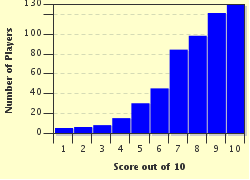Quiz Answer Key and Fun Facts
1. Please name the three naturally occurring isotopes (isotopes are different forms of one element, resulting from a variation in the number of neutrons within an element's nucleus) of hydrogen.
2. Which element has an atomic number (the number of protons in an atom's nucleus, it also represents the number of electrons orbiting the nucleus) of 10?
3. Which of the following is the correct electron configuration for the element sodium?
4. Tungsten has the symbol 'W', but what does the letter 'W' stand for?
5. The chemical symbol for mercury is 'Hg', but from what is this symbol derived?
6. Lead has the symbol 'Pb', but where is this derived from?
7. Which of the following scientists was one of the men who synthesised berkelium?
8. Who discovered polonium?
9. Which of the following was one of the scientists who synthesised darmstadtium?
10. Could you please define the word element.
Source: Author
DanielPoulson
This quiz was reviewed by FunTrivia editor
crisw before going online.
Any errors found in FunTrivia content are routinely corrected through our feedback system.

